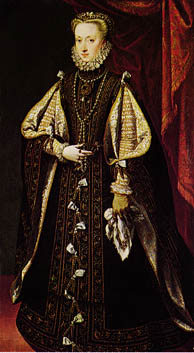
Anne of Austria, Queen of Spain
C. 1571
KunstHistorisches Museum, Vienna, Austria
Anne originated in Austria, but for this portrait she wears the costume of her adopted country.
As travel and communication increased throughout the continent during the latter half of the century, fashion became more international. National styles did exist, but were not exclusive; among the English upper classes, "Frenche kirtles","Spanish Grete Sleeves", and "Bodices of the Italian Fashion" became common and quite fashionable items to wear; and Queen Elizabeth's love of foreign styles of dress played no small part in their popularity.
Such was also the case with Spanish dress. Queen Anne's gown is a good example of upper class Spanish fashion, and contains many of the stylistic motifs that spread to other countries and influenced fashion on an international scale.
Black was, and had been for decades, a popular color for fashionable
clothing in Spain. As the
century progressed, this fondness for black spread to the neighboring
countries of England, France and other parts of the continent. It became
fashionable to wear somber, all-black outfits, which emphasized the
fashionable pallor of a lady's (or gentleman's) skin.
Incidentally, a "melancholic" attitude, one of passivity and gentle
depression, became fashionable at the same time.*
A portrait of an Englishwoman wearing black,
painted some five years after this one, is likely a product of this
international migration of Spanish fashion.
Anne's bodice covers her from hips to neck, and is decorated with vertical strips of embroidery down the front. In fact, the bodice more resembles a man's doublet than the square-necked bodices popular in earlier years. This new style is thought by some to have originated in Spain and spread to other countries, though there's evidence that English high-necked bodices existed beforehand. Regardless, the high-necked bodice became all the rage in many countries during the 1570s and 80s; It almost always fastened down the front, usually with buttons, sometimes with hooks and eyes. A portrait of the Queen's Cousin Lettice, painted in 1585, shows a similar type of bodice worn by an Englishwomen. The vertical bands of decoration down the front and continuing down the front of the skirt also became internationally fashionable during this time; there are examples of back-closing bodices with similar frontal decoration on them.
The sleeves of Anne's gown are also a singularly Spanish style. Known as a "Spanish Great-Sleeve", this long, bell-shaped sleeve, caught at the wrist, displays a close-fitting undersleeve decorated with a series of gathered bands all the way up the arm. This style had its origins in Tudor Spanish and Portugese fashion (see the Portrait of Isabella of Portugal, painted in 1536, for a view of the sleeve's ancestor), but during the 1580s the style spread to other countries. Elizabeth I's wardrobe specifies a number of gowns with "Spanysshe Grete Sleves".
In spanish fashion, the undersleeve worn with such an oversleeve was usually close-fitting and decorated with horizontal bands of trim or gathers. The Portrait of the Duchess de Guiche is one example of this popular over- and under-sleeve combination. Another small item of note is the alternating way in which the points, or ribbons with metal tips on the ends, which fasten the front of the skirt together are tied; this alternation is also seen in other portraits where the overskirt is tied together in front, rather than held open to display a decorated forepart or underskirt.
Anne of Austria's hair is dressed in a popular Elizabethan style: parted in the middle, each side is puffed into a roll on either side of the forehead. (If anyone has a reliable and stable method for doing this, please let me know!)
*Which proves, once and for all, that Goth is indeed an
Englishman. :)
(Sorry, I had to say it)